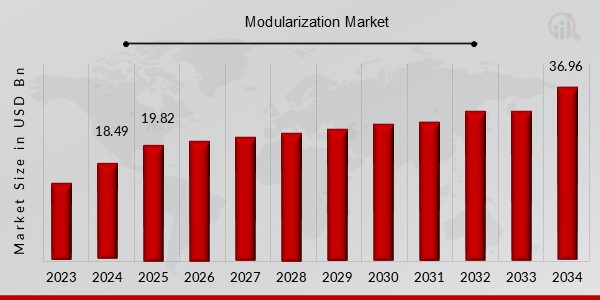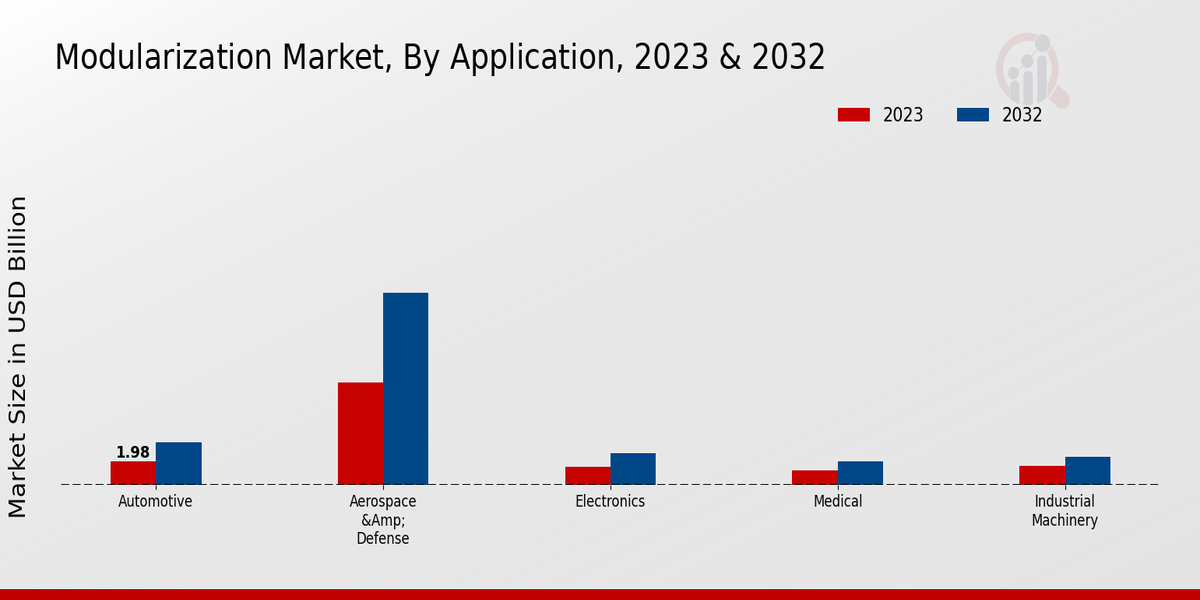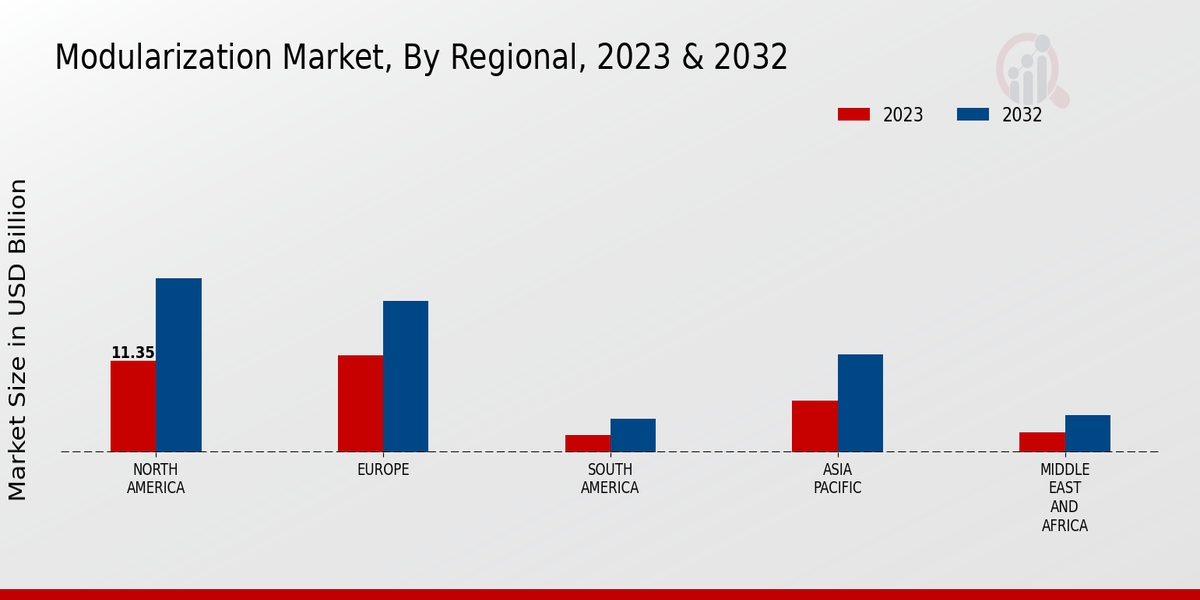Global Modularization Market Overview
The Modularization Market Size was estimated at 18.49 (USD Billion) in 2024. The Modularization Industry is expected to grow from 19.82 (USD Billion) in 2025 to 36.96 (USD Billion) by 2034, with a CAGR (Growth Rate) of approximately 7.2% during the forecast period (2025–2034).
Key Modularization Market Trends Highlighted
The modularization market is experiencing a surge due to the increasing demand for customizable and scalable solutions. This trend is driven by advancements in technology, such as cloud computing and microservices, which enable organizations to adopt a modular approach to building and deploying applications. Additionally, the rise of agile development practices has fostered the adoption of modularization, as it allows for faster and more efficient code updates and enhancements.Emerging opportunities in the modularization market lie in the integration of artificial intelligence (AI) and machine learning (ML) techniques. AI and ML can automate the process of identifying and encapsulating independent modules, leading to improved efficiency and reduced development time. Furthermore, the growing popularity of serverless computing and edge computing creates additional opportunities for modularization, as these technologies require flexible and adaptable solutions that can meet the demands of distributed systems.
Recent trends in the modularization market include the adoption of low-code and no-code platforms. These platforms simplify the development process, making it accessible to a broader range of users. Additionally, the increasing use of open-source modularization frameworks and toolkits is contributing to the market's growth, as they provide developers with a wide range of ready-to-use modules and components.

Source: Primary Research, Secondary Research, MRFR Database and Analyst Review
Modularization Market Drivers
Growing Demand for Modular Construction
The construction industry is transforming to include an increasing amount of modular construction. This method involves prefabricating building components in a factory setting integrated with appropriate storage and logistics. It is superior in many ways to standard construction, as it reduces the time it takes to build, maintains higher quality standards by allowing all work to be monitored closely, and reduces waste. As the demand for modular construction increases across the world, so does the modularization market: The Modularization Market Industry is projected to grow in the future, with various market drivers, including increasing demand from multiple sectors, such as residential, commercial, healthcare, and education, playing their roles.
Advancements in Technology
The modularization market is also being driven by advancements in technology. These advancements include the development of new materials and technologies that are making modular construction more efficient and cost-effective. For example, the development of lightweight and durable materials is making it possible to construct taller and more complex modular buildings. In addition, the development of automated construction technologies is helping to reduce the labor costs associated with modular construction. These advancements in technology are making modular construction a more attractive option for a wider range of projects.
Government Regulations and Incentives
Government regulations and incentives are also factors that are driving the growth of the modularization market. Many governments are now introducing regulations to encourage the adoption of modular constructions. For example, some government bodies are now offering tax breaks to projects that use modular construction. Some governments now require the use of modular construction for specific projects like the construction of affordable housing. These laws and financial incentives are some of the factors that are tilting the balance in favor of modular construction for developers and contractors.
Modularization Market Segment Insights
Modularization Market Application Insights
Application The application segment is one of the most essential ones to influence the development of the Modularization Market. Automotive, Aerospace Defense, Electronics, Medical, and Industrial Machinery are certain applications that should be improved and that can contribute to the further development of the Modularization Market in the future.
The automotive industry remains one of the most influential ones in developing the Modularization Market. The growing interest in lighter, less fuel-consuming, and more easily adaptable vehicles stimulates the use of modular platforms in manufacturing. Besides, modularization often allows automakers to simplify the existing process of vehicle assembly and reduce time spent on it to improve the performance of the vehicle produced. Finally, the growing popularity of electric vehicles leads to the overall growth of the modular platforms intended for the automotive industry.
Aerospace Defense remains an application that cannot survive without properly developed modularization. The Aerospace Defense sector aims at the development of lighter vehicles that can be easily and quickly assembled, repaired, and modernized. In addition, the growing interest in the development of superior defense systems and rapid deployment strategies contributes to the overall growth in the use of modular components. In other words, the Aerospace Defense industry requires modern modular platforms to perform properly.
Electronics can also be discussed as an industry that benefits from and enhances the growth of the Modularization Market. Modern electronic devices purchased by people worldwide are popular, including smartphones, tablets, and IoT systems, because they are easy to upgrade, modernize, and adapt to the specific requirements of users. There is also a tendency to decrease the size and integrate all the control, communication, and other devices into the smallest possible spaces. Therefore, the increasing use of the development of modular design leads to the general growth in the use of modularization.
The healthcare industry, as in the medical one, is also characterized by the growing use and benefits brought to the field by modularization. The use of modular concepts allows medical devices to be easily adapted to the needs of patients and the requirements of healthcare providers to improve the circumstances and instruments of patient care. Surgeons require modules to equip them with robotic assistants or laboratory professionals to examine the samples. Patients will have an excellently responsive, determinately effective machine that they get to live with. The use of modularization concepts is critical throughout industries that attract so much interest and require truly careful attention. For the healthcare industry, that is a path of development that allows avoiding the need to do most of the calculations manually for the benefit of greater precision.
Additionally, the last application considered to determine the benefits and the growth of the Modularization Market is the Industrial Machinery sector. Manufacturing enterprises continue developing themselves. It defines the need of industrial machinery manufacturers to decrease the time and cost spent on the production of the machinery, ensuring that the machinery produced meets all the newly set requirements. Industrial machinery manufacturers employ modular components to quickly adapt and readapt their machines to the requirements of the enterprise in case of production changes.The growing popularity of automation as a way of responding to manufacturing clients in an efficient way also influences the growth of the Modularization Market. To conclude, the application segment has all the opportunities to contribute positively to the overall development of the Modularization Market. Most industries experience the growing popularity and the increased number of advantages provided by modular designs. The growing popularity of lightweight, easily adaptable, and effective production and usage methods stimulates the growth of the Modularization Market.
Source: Primary Research, Secondary Research, MRFR Database and Analyst Review
Modularization Market Type Insights
Picture. Modularization Market by Type The Modularization Market is segmented by Type into Mechanical Modularization, Electrical Modularization, and Software Modularization. The mechanical Modularization segment is anticipated to account for the largest market share during the assessment periods owing to its increasing adoption across various industries, including manufacturing, automotive, aerospace, and others. The electrical Modularization segment is also poised to grow at a relatively steady rate as this segment continues to witness rising demand from power generation and distribution, automation, and other related industries.However, software modularization is also expected to become more attractive over the specified periods as it enables users to enjoy higher flexibility, rapid go-to-market time, and reduced development costs.
Modularization Market Material Insights
The market segmentation includes Material, which comprises Metal, Plastic, and Composite. Among these materials, Metal holds the largest market share due to its high strength-to-weight ratio, durability, and resistance to corrosion. Plastic is another commonly used material in modularization, offering advantages such as lightweight, cost-effectiveness, and design flexibility. Composite materials, a combination of metal and plastic, provide a balance of properties, including high strength, lightweight, and corrosion resistance, making them suitable for various applications.The growth of the modularization market is attributed to the increasing demand for lightweight and efficient vehicles, rising adoption of modular construction techniques in various industries, and growing investments in infrastructure development.
Modularization Market Size Insights
The Modularization Market is segmented by size into Small, Medium, and Large. The Small segment is expected to hold the largest share of the market in 2023 and is projected to continue to grow at a steady pace over the forecast period. The Medium segment is expected to grow at a faster rate than the Small segment and is projected to account for a significant share of the market by 2034. The Large segment is expected to grow at the slowest rate, but is still projected to contribute a significant amount of revenue to the overall market. The growth of the Modularization Market is attributed to the increasing demand for modular products and solutions across various industries, including automotive, electronics, and healthcare.Modularization offers several advantages, such as reduced costs, improved efficiency, and increased flexibility, which is driving its adoption in various applications.
Modularization Market Distribution Channel Insights
The distribution channel segment plays a crucial role in shaping the Modularization Market. In 2023, the Modularization Market was valued at 16.09 USD Billion, and it is projected to reach 30.0 USD Billion by 2032, exhibiting a CAGR of 7.17%. Direct sales, distributors, and OEMs are the primary distribution channels for modularization solutions. Direct sales involve selling modularization products and services directly to end-users, offering benefits such as personalized customer service, technical support, and tailored solutions. Leading players in the Modularization Market leverage direct sales to establish strong customer relationships and capture a significant market share.Distributors act as intermediaries between manufacturers and end-users, providing logistics, warehousing, and distribution services. They offer a wider reach and access to regional markets, enabling manufacturers to expand their market presence. OEMs (Original Equipment Manufacturers) integrate modularization solutions into their products and systems, catering to specific industry requirements. Collaborations between modularization providers and OEMs drive innovation and create customized solutions that meet the evolving needs of end-users. The choice of distribution channel depends on factors such as product complexity, target market, and geographical reach, with each channel offering unique advantages and challenges.
Modularization Market Regional Insights
Regionally, North America accounted for the largest market share in 2024 and is projected to maintain its dominance throughout the forecast period. The region's strong manufacturing base, coupled with the presence of major players in the modularization industry, contributes to its significant market share. Europe is another key region in the Modularization Market, driven by the growing adoption of modular construction techniques in the region. The increasing focus on sustainability and energy efficiency in construction is also driving the growth of the modularization market in Europe.The APAC region is expected to witness the fastest growth over the forecast period, owing to the rising demand for modular buildings in rapidly developing countries like China and India. South America and MEA are also expected to experience steady growth in the modularization market, as governments in these regions are increasingly recognizing the benefits of modular construction.

Source: Primary Research, Secondary Research, MRFR Database and Analyst Review
Modularization Market Key Players And Competitive Insights
Business players in the Modularization Market are leveraging their expertise to focus on innovations and developing cost-effective solutions to cater to the increasing demand for modularization solutions in different end-use industries. Prominent players in the Modularization Market have introduced research and development investments to create more feature-rich solutions. The Modularization Market is projected to record a surge in the number of adopters with the growth in the number of modularization techniques in use across different industry sectors. The Modularization Market has a blend of available providers and new entrants with both categories competing to enhance their capabilities and adaptability as well as advance their modularization solutions and expand their global foothold through acquisitions, partnerships, and various collaborations.A prominent force in the Modularization Market, ABB provides diverse modularization offerings in several industries. ABB offers different modularization options with a variety of modular switchboards, modular power solutions, and modular automation systems. The company’s modularization solutions are designed to enhance efficiency, safety, and reliability in various hyperindustries. “ABB operates in more than 100 countries with about 144,000 employees” and brings together manufacturers such as Baldor Electric and Thomas Betts to expand its capabilities in meeting the increasing customer needs. It continues to enhance its solutions in the modularization Market.Another leading force, Schneider Electric, is a fierce competitor in the Modularization Market. The company offers customers modularization options, including modular enclosures, modular power, and modular control solutions. The solutions are designed to offer customers with ease and efficiency in installation and are highly flexible for scale development. With operations in more than 100 countries, Schneider Electric has the largest number of modular providers in the market. Both companies drive innovation as a means of maintaining their stance in the Modularization Market.
Key Companies in the Modularization Market Include
- Siemens
- Yaskawa Electric
- Hitachi
- Rockwell Automation
- Eaton
- ABB
- Honeywell
- Mitsubishi Electric
- General Electric
- Omron
- Schneider Electric
- Grundfos
- Emerson Electric
- Danfoss
- Flowserve
Modularization Market Industry Developments
Recent developments in the Modularization Market indicate a growing demand for modular construction methods across various industries. The construction sector, in particular, is embracing modularization to enhance efficiency, reduce costs, and improve sustainability. Key market players are investing in research and development to advance modular construction technologies, leading to the introduction of innovative materials and design solutions. The increasing adoption of digital tools and Building Information Modeling (BIM) is further streamlining the modularization process, facilitating collaboration and optimizing project outcomes. Furthermore, government initiatives and regulations promoting sustainable building practices are driving the growth of modularization, as it offers reduced waste and environmental impact compared to traditional construction methods.
Modularization Market Segmentation Insights
Modularization Market Application Outlook
- Automotive
- Aerospace Defense
- Electronics
- Medical
- Industrial Machinery
Modularization Market Type Outlook
- Mechanical Modularization
- Electrical Modularization
- Software Modularization
Modularization Market Material Outlook
Modularization Market Size Outlook
Modularization Market Distribution Channel Outlook
- Direct Sales
- Distributors
- OEMs
Modularization Market Regional Outlook
-
North America
-
Europe
-
South America
-
Asia Pacific
-
Middle East and Africa
| Report Attribute/Metric |
Details |
| Market Size 2024 |
18.49 (USD Billion) |
| Market Size 2025 |
19.82(USD Billion) |
| Market Size 2034 |
36.96(USD Billion) |
| Compound Annual Growth Rate (CAGR) |
7.22% (2025 - 2034) |
| Report Coverage |
Revenue Forecast, Competitive Landscape, Growth Factors, and Trends |
| Base Year |
2024 |
| Market Forecast Period |
2025 - 2034 |
| Historical Data |
2020 - 2025 |
| Market Forecast Units |
USD Billion |
| Key Companies Profiled |
Siemens, Yaskawa Electric, Hitachi, Rockwell Automation, Eaton, ABB, Honeywell, Mitsubishi Electric, General Electric, Omron, Schneider Electric, Grundfos, Emerson Electric, Danfoss, Flowserve |
| Segments Covered |
Application, Type, Material, Size, Distribution Channel, Regional |
| Key Market Opportunities |
Rising construction costs Growing urban population Increased demand for sustainability Technological advancements Government incentives |
| Key Market Dynamics |
Rising construction costs, increasing demand for offsite construction, growing adoption of prefabrication urbanization and industrialization technological advancements. |
| Countries Covered |
North America, Europe, APAC, South America, MEA |
Frequently Asked Questions (FAQ) :
The Modularization Market is expected to reach a valuation of 18.49 billion USD in 2024.
The Modularization Market is projected to grow at a CAGR of 7.2% from 2025 to 2034.
The Modularization Market is expected to reach a valuation of 36.96 billion USD by 2034.
North America is expected to hold the largest market share in the Modularization Market in 2024.
The automotive industry is expected to drive the growth of the Modularization Market.
Key competitors in the Modularization Market include ABB, Siemens, Rockwell Automation, Schneider Electric, and Emerson Electric.
Key trends driving the growth of the Modularization Market include the increasing demand for automation, the growing adoption of Industry 4.0, and the need for improved efficiency.
Challenges facing the growth of the Modularization Market include the high cost of implementation, the lack of skilled labor, and the complexity of integration.
Growth opportunities for the Modularization Market include the increasing adoption of cloud-based solutions, the growing demand for predictive maintenance, and the expansion of the market into new regions.
Key applications of modularization in the manufacturing industry include assembly, testing, and packaging.
















